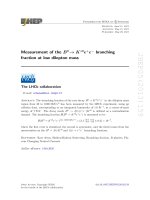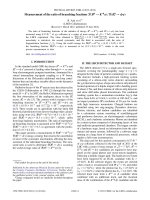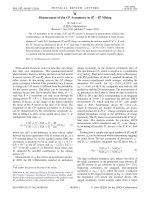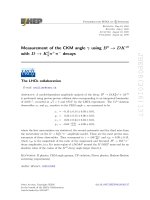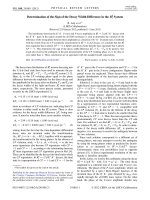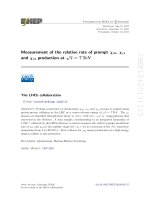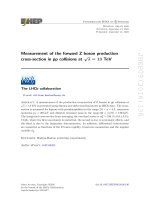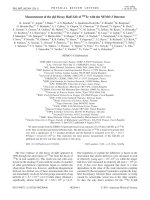DSpace at VNU: Measurement of the B-s(0) - D-s(() D-)+(s)( ()-) branching fractions
Bạn đang xem bản rút gọn của tài liệu. Xem và tải ngay bản đầy đủ của tài liệu tại đây (313.22 KB, 5 trang )
PhysicsLetters B 305 (1993) 177-181
North-Holland
PHYSICS LETTERS B
Measurement of relative branching fractions
for D ÷
K-K+K + and Ds+ - - , n - n +n ÷ decays
WA82 Collaboration
M. Adamovich e, y . Alexandrov e, F. Antinori b, D. Barberis c, W. Beusch b, A. Buys d,
V. Casanova c, M. Dameri c, M. Davenport b, j.p. Dufey b, A. Forino ", B.R. French b,
R. Gessaroli ", F. Grard d, K. Harrison b, R. Hurst ¢, A. Jacholkowski b, A. Kirk b, E. Lamanna b,
J.C. Lassalle b, p. Legros d, p. Mazzanti ", F. Muller b.~, p. Netchaeva *, B. Osculati c,
A. Quareni a, N. Redaelli b, C. Roda b, L. Rossi ~, G. Tomasini c, M. Weymann b and
M. Zavertyaev ~
a Dipartimento di Fisica and INFN, Bologna, Italy
b CERN, European OrganizationforNuclearResearch, Geneva, Switzerland
Dipartimento di Fisica and INFN, Genova, Italy
d Universitd de Mons-Hainaut and IISN, Mons, Belgium
Lebedev Physical Institute, Moscow, Russian Federation
Received 27 February 1993
The decaymodesD,+ -,lt-n +n + and D + - - , K - K +K + havebeen studied in the hadroproductionexperimentWA82.The following ratios of branchingfractionshave been measured:
B(D{ - ~ n - n + n
+ ) / B ( D { --*On+ ) =0.33+_0.10_+0.04,
B ( D + ~ K - K + K + ) / B ( D + - , K - n + n + ) =0.057_+0,020+0.007,
B(D+-.K-K+K+)/B(D+
~On+)=0.49+0.23_+O.06.
Much theoretical work has been carried out in
trying to understand the so-called charm-decay puzzle [ 1 ] and, in particular, the difference between the
lifetime of the D + meson and the lifetimes of the D°
and D + mesons. Effects of possible relevance include non-leptonic decays occurring via processes not
described by spectator diagrams, final-state interactions and the destructive interference that may arise
in the Cabibbo-favoured decays of the D ÷ but not in
the decays of the D °. It is noted that doubly Cabibbosuppressed D ÷ decays are not subject to destructive
interference, therefore their relative branching fractions might be enhanced [ 2 ].
In a previous paper [ 3 ] we reported on the WA82
t Deceased.
measurements of the relative branching fractions of
D O Cabibbo-suppressed decays. Here we present results based on an analysis of the three-body decays
D~+ - * n - n +n + and D + ~ K - K + K
+ (the charge conjugate states will be implicitly included throughout
this paper). These decays cannot be described
by simple spectator diagrams, but must involve annihilation subprocesses or final-state rescattering.
Furthermore, the D + - - , K - K + K + mode is doubly
Cabibbo-suppressed. The E691 Collaboration has
observed the decay Ds+ - ~ n - n + n + [4] in addition
to the decay D +-~ n - n + n + previously reported by
the Mark lII Collaboration [5]. The decay D + ~
K - K + K + has been studied by the E691 Collaboration [ 6 ] in the c-resonant mode only.
In the WA82 experiment the CERN Omega Spec-
0370-2693/93/$ 06.00 © 1993 Elsevier SciencePublishers B.V. All rights reserved.
177
Volume 305, number 1,2
PHYSICS LETTERS B
trometer, supplemented with a silicon microstrip detector, was used to study charmed hadrons produced
by interactions of 340 G e V / c n - mesons on a 2 m m
thick target. On-line enrichment for charmed particles was achieved by triggering on events in which at
least one track was found to miss the primary interaction vertex by more than 100 gm. Some 5 × 107
events were recorded and are used in the present
analysis. For 60% o f the data, particle identification
was provided by a Ring Imaging Cherenkov detector
( R I C H ) . The experimental set-up, the trigger requirements and the data processing have been fully
described in previous publications [ 7 ].
Identification o f charmed particles was made possible by the high precision in secondary vertex reconstruction (30 /am transversally, 500 g m longitudinally) provided by the silicon microstrip telescope.
The present analysis o f three-body decays is similar
to our previous analysis o f decays of the D O [ 3 ]. Invariant mass distributions were obtained for events
where a secondary vertex was found outside the thin
target and where the longitudinal separation between
the secondary vertex and the primary interaction
vertex was greater than 6 standard deviations. When
extrapolated backwards the reconstructed momentum vector o f a decay candidate was required to pass
within 30 g m o f the primary vertex.
Particle identification with the R I C H was performed using the following procedure: first chisquared probabilities, derived from expected and observed numbers of photo-electrons and ring radii,
were obtained for the different mass hypotheses; next
conditional probabilities were calculated using a
priori probabilities determined from the data through
an iterative method [8]; then the results were expressed in terms o f ratio between the conditional and
the a priori probability for each mass hypothesis ( x e
denotes this ratio for particle hypothesis P = n, K, p
in the following discussion); finally, particles were
identified by cutting on xe. The R I C H identification
efficiency for kaons has been determined experimentally as a function of m o m e n t u m by considering the
signals for D Oand D + Cabibbo-favoured decays.
Fig. 1 shows our signals for 0-resonant D~+ --,
K - K + n + and D + - - , K - K + n + , without and with
R I C H identification, the latter obtained by requiring
that xK, the ratio o f the kaon probability to the kaon
178
6 May 1993
(a)
3o
0
09
25
2o
>
LLJ
17
175
18
185
19
195
2
205
m ( K K*7~+)
21
215
Oev"~
(b)
(D
0
60
10
8
c
>
hA
0
J
7
175
18
185
19
195
rn ( K-K *7~+ )
2
205
21
215
0eV/" 2
Fig. h (a) K - K + ~ + invariant mass distribution for full data
sample, m ( K - K +) within 10 MeV/c 2 of the ¢ mass, no RICH
identification. (b) K - K * g ÷ invariant mass distribution for the
60°/0 of the data for which RICH information is available,
m ( K - K + ) within 10 MeV/c 2 of the ¢ mass, x~>0.5 for both
kaon candidates.
a priori probability, be greater than 0.5 for both kaon
candidates. Fig. 2a shows the D + - - - , K - g + n ÷ signal
without R I C H identification. The signal over noise
ratio can be further improved by cutting on the proper
lifetime of the decay candidate, as shown in fig. 2b.
Fig. 3 shows the g - g + g + invariant mass distribution for the full data sample, where the large peak
appearing to the left o f the D + and D~+ signals is due
to the reflection of D + - - , K - g +g ÷ in which the kaon
is wrongly assumed to be a pion. The R I C H identification is not used for this mode since the background
under the signals is mostly made ofpions. Instead we
have asked that the calculated proper lifetime, r, of a
decay candidate should be greater than some specified value. Results are shown in fig. 3a for r > 0.5 ps
and in fig. 3b for r > 0 . 8 ps. The cut z > 0 . 8 ps eliminates a substantial part of the D~+ signal, while the
Volume 305, n u m b e r 1,2
PHYSICS LETTERS B
~(j
6 May 1993
45
(a)
(o)
~ " 200
@
~75
0
50
~
125
O9
~ . 25
~
100
2ksJ
to
T>O.5ps
55
~5o
20
15
25
1 75
1 8
I 85
1 9
1
2
95
3
t
D
0
>
2.5
~
2
18
21
85
19
OeV/c 2
m(K-Tz+7~ ÷)
(1)
205
t/b/
195
2
2.05
21
215
rYl ( 7s-7s+ 7s +
22
OeV/c 2
~25
b
2o
Q~) 17 5
O3
125
1.5
@
75
5
O
0.5
25
o12
' 'oi,
' '0,6'
' '0,8'
--lJ~u~-- 4
' ' I ' ' I l l12
T~,o(ps)
Fig. 2. (a) K - n +zt + invariant mass distribution for the full data
sample, no RICH identification. (b) Relative values of signalto-background ratio (S/B) and signal (S) as a function of the
cut on proper lifetime ~> zmi,. Values are norrnalised to 1 for no
explicit proper lifetime cut (i.e. when there are only the requirements of trigger and filter and the requested vertex separation).
D + signal is little affected, as is to be expected from
the D ÷ and D~+ lifetimes. For the calculation of relative branching fractions we obtain a reduced background, with no significant loss of statistics, by requiring r > 0.8 ps when considering D + and ~> 0.5 ps
when considering D + .
Fig. 4a shows the K - K + K ÷ invariant mass distribution for the data sample for which RICH information was available. In order to optimise background reduction, while keeping evidence of a signal,
we request x r > 0.5 for both K + candidates. In this
analysis we do not consider secondary vertices that
are compatible within 15 MeV/c 2 with D+--.
K - T t + n +, with D+ / D s+ --.(bzt +, with A~+ --,p K - z t +
or within 10 MeV/c 2 with K ° - - , n - n + to which a
third track was associated. The RICH cut approximately halves, to 13.1 + 4.5, the number of events in
0
'18'
' '165
]9
195
2
205
m (7r-7~+7~ + )
21
2}5
22
OeV/c:
Fig. 3 . ~ - n + ~ + invariant mass distribution for full data sample,
no RICH identification, cuts on proper lifetimes as indicated.
the peak at the D ÷ mass. This is consistent with the
RICH efficiency for the mode considered
(0.40+0.03). By contrast, the background is reduced by more than a factor of 5. To further reduce
the background and check the compatibility of the
observed peak with a D + signal, we have also applied
cuts on proper lifetime, obtaining the invariant mass
distribution shown in fig. 4b for z> 1.3 ps. There is
then a peak of 5.7+2.8 events at the D + mass, in
agreement with the expected number of 4.1 + 1.5 according to fig. 2b.
The number of events in the various decay modes
was determined by maximum likelihood fits to the
invariant mass distributions, as in ref. [3]. Signal
peaks are fitted with gaussians. Linear functions are
used to describe the structureless backgrounds except
in the case of the K - K + K ÷ mode, where a quadratic
function is adopted. The tail of the reflection peak in
the n-z~+n + distribution is modelled as a Breit179
Volume 305, number 1,2
>
0
"~.
--
35
PHYSICS LETTERS B
x~ > O 0
×. > 0 . 5
(o)
F:
;l
"
ii
50
rl
:;
[k, r, ~'-ir,
25
6 M a y 1993
Table 1
Number of events in the three-body D ÷ and D 2 decay modes for
the different selection criteria.
Decay mode
r[ ,,L,
m
r(ps)
xx
D+~K-rc+zc +
939
425
>0.5
Ld
15
D +--,¢~r +
16
17
~8
lg
2
21
m (k-I~ +t< ÷ )
%
>
I0
[ ~
T
32.7_+ 9.0
19.3_+ 6.0
>0.5
45.8_+ 8.3
19.4_+ 6.0
g
>
LI
D+-,n-n+n+
D + --*rr-n +~r +
>Ops
T > ]5
0
22
Oev/c:
x~ > 0 5
ps
8
D+~,K-K+K +
>0.5
>0.5
>0.5
19.5_+ 7.1
>0.8
19.7_+ 7.0
>0.5
>0.8
28.6_+ 8.4
11.7_+ 5.1
> 1.3
13.1_+ 4.5
5.7_+ 2.8
6
Table 2
Comparison of WA82 results with P D G values.
4
5
16
17
18
19
m(K-K+K
2
+)
21
22
CeV/c 2
F(D+~n-n+n
+)
F(D + ~K-n+n + )
WA82
PDG
0.032+0.011 +0.003
0.035_+0.007
0.075_+0.007
Fig. 4. ( a ) K - K + K + invariant mass distribution for the 60% of
data for which RICH information is available, with no R I C H
identification (dotted line) and with x x > 0.5 for both K ÷ candidates (solid line ). ( b ) Upper curve as solid line of ( a ) ; shaded
area with additional requirement z > 1.3 ps.
F(D+--'~rt+)
F ( D + --*K - n + n + )
0.062+0.017+0.006
F(D+~n-n+n+)
F(D +~On +)
F(D~n-n+~r +)
0.52 _+0.23 + 0 . 0 5
Wigner curve, as given by simulated data for
F ( D+ ~ K - K + K + ) 0.057-+0.020_+0.007
F(D+-,K-rt+rt + )
F(D + --,K-K+K +)
0.49 + 0 . 2 3 _+0.06
F ( D + --, (bn + )
D + - - , K - n +n +. When considering signals other than
D+~K-n+n
+, the D + and D~+ masses are fixed to
the P D G values [ 9 ] and peak widths are those determined from simulated events: a = 8 . 3 M e V / c 2 for
D + - - , n - n + n +, 7.1 M e V / c 2 for D + - - , n - n + n + and
5.3 MeV/c 2 for D + - , K - K + K +. The simulated
events, generated using PYTHIA [ 10] and passed
through a detector simulation program, have been
subjected to the same selection criteria and analysis
procedures as the experimental data. The numbers of
events obtained in the different modes are given in
table 1.
Relative detection efficiencies for the decay modes
considered have been determined from the simulated data [ 11 ]. The effect on the rr-rt+n+ and
K - K + K + invariant mass distributions o f the proper
lifetime cuts used in our analysis is compatible with
180
_+45
_+34
>0.5
D + --,¢zr +
15
Number of events
F(D~+ ~On + )
0.33 + 0 . 1 0
_+0.04
0.44 + 0 . 1 0
+0.04
the expectations both from simulation and from the
observed reduction of the D + ~ K - n + n ÷ signal. Our
results are summarized in table 2 and are compared
with the current P D G data [ 9 ]. For each of our measurements the first error quoted is statistical and the
second is systematic, taking into account uncertainties in the calculated detection efficiencies and different parameterisations o f the background. Our results
for previously established modes are in agreement
with the P D G values. Of particular interest, we find
B(D~+ ~rc-z~ +~r÷ ) = 0 . 3 3 + _ 0 . 1 0 + 0 . 0 4 .
B ( D + --,On + )
Volume 305, number 1,2
PHYSICS LETTERS B
F o r D + - - . K - K + K +, w i t h o u t cut o n p r o p e r lifetime,
we o b t a i n
B(D+-*K-K+K+ ) =0.057+0.020+0.007,
B(D+-,K-rc+~r +)
B ( D + o K - K + K + ) = 0.49 + 0,23 + 0.06 .
B(D+ ~¢zt + )
W i t h the cut z > 1.3 ps, we m e a s u r e
B ( D + ~ K - K + K + ) = 0.069 + 0.034 + 0 . 0 0 9 ,
B(D+~K-rc+rc +)
c o n s i s t e n t with the result given above. We f i n d n o
e v i d e n c e for D + ~ K - K + K + or for a significant
D + ~q~K + r e s o n a n t c o n t r i b u t i o n i n D + - - , K - K + K +.
This latter o b s e r v a t i o n is n o t i n c o m p a t i b l e with the
E691 result [6] o f B ( D + ~ ¢ ) K + ) / B ( D + - - , ¢ ) n + ) =
(~J . o -Q+3.2
-2.
6 -+
- 0.7) × 10-% w h i c h in o u r data w o u l d give
a signal o f 1.3 events (with n o cut o n proper lifetime).
In c o n c l u s i o n , we have m e a s u r e d relative b r a n c h ing fractions for some D + a n d D + decays. This analysis i n c l u d e s the study o f a n e w d o u b l y C a b i b b o - s u p pressed decay D + ~ K - K + K + in the n o n - r e s o n a n t
6 May 1993
m o d e , the i d e n t i f i c a t i o n of which was possible using
RICH information.
References
[ 1 ] I.I. Bigi, in: Heavy quark physics, eds. P.S. Drell and D.L.
Rubin, AlP Conf. Proc. No. 196 (American Institute of
Physics, New York, 1989), and references therein.
[2] I.I. Bigi, Proc. 16th SLAC Summer Institute on Particle
physics, ed. E.C. Brennan (Stanford University, Stanford,
CA, 1988).
[ 3 ] M. Adamovich et al., Phys. Lett. B 280 (1992) 163.
[4] J.C. Anjos et al., Phys. Rev. Lett. 62 (1989) 125.
[ 5 ] R.M. Baltrusaitis et al., Phys. Rev. Lett. 56 (1986) 2140.
[6] J.C. Anjos et al., Rev. Len. 69 (1992) 2892.
[7] M. Adamovich et al., IEEE Trans. Nucl. Sci. 37 (1990) 236;
Nucl. Instrum. Methods A 309 ( 1991 ) 401.
[8 ] A. Buys, Dissertation de doctorat, Universit~ de MonsHainaut (1992).
[9] Particle Data Group, K. Hikasa et al., Review of particle
properties, Phys. Rev. D 45 (1992) I.l
[ 10] Lund Monte Carlo Programs Manual (CERN, November
1989).
[11 ] A. Buys, Internal report PNPE-312, Universit6 de MonsHainaut (1993).
181
